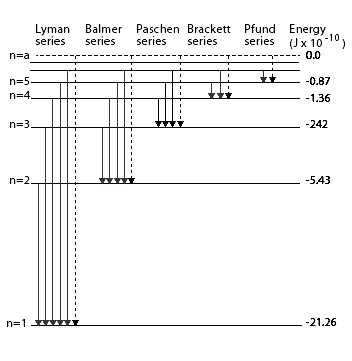
Name the series of hydrogen spectrum which lies in the ultraviolet region.
Answer
499.8k+ views
Hint: Each element has a characteristic spectrum of radiation, which it emits. A particular element would exhibit some regular pattern with emitted light frequencies. Hydrogen is the simplest atom and therefore, has the simplest spectrum.
Complete step by step answer:
The atomic hydrogen emits a line spectrum consisting of various series. In the hydrogen spectrum, the spacing between lines within certain sets of the hydrogen spectrum decreases in regular ways. Each of these sets are called spectral series. Balmer, Lyman, Paschen, brackett, and Pfund series are subsequently found in spectral series of the hydrogen spectrum at different wavelengths.
Lyman series:
The Lyman series is in the ultraviolet region.
According to third postulate of Bohr’s model, when an atom makes a transition from the higher energy state with quantum number
Since both

Hence, from the above hydrogen spectrum, the series which lies in the ultraviolet region is the Lyman series.
Note: The various lines in the atomic spectra are produced when electrons jump from higher energy state to lower energy state and photons are emitted. These spectral lines are called emission lines. But when an atom absorbs a photon that has precisely the same energy needed by the electron in a lower energy state to make transitions to a higher energy state, this process is called absorption.
Complete step by step answer:
The atomic hydrogen emits a line spectrum consisting of various series. In the hydrogen spectrum, the spacing between lines within certain sets of the hydrogen spectrum decreases in regular ways. Each of these sets are called spectral series. Balmer, Lyman, Paschen, brackett, and Pfund series are subsequently found in spectral series of the hydrogen spectrum at different wavelengths.
Lyman series:
The Lyman series is in the ultraviolet region.
According to third postulate of Bohr’s model, when an atom makes a transition from the higher energy state with quantum number
Since both

Hence, from the above hydrogen spectrum, the series which lies in the ultraviolet region is the Lyman series.
Note: The various lines in the atomic spectra are produced when electrons jump from higher energy state to lower energy state and photons are emitted. These spectral lines are called emission lines. But when an atom absorbs a photon that has precisely the same energy needed by the electron in a lower energy state to make transitions to a higher energy state, this process is called absorption.
Recently Updated Pages
Master Class 11 Economics: Engaging Questions & Answers for Success

Master Class 11 Business Studies: Engaging Questions & Answers for Success

Master Class 11 Accountancy: Engaging Questions & Answers for Success

Master Class 11 English: Engaging Questions & Answers for Success

Master Class 11 Computer Science: Engaging Questions & Answers for Success

Master Class 11 Maths: Engaging Questions & Answers for Success

Trending doubts
State and prove Bernoullis theorem class 11 physics CBSE

1 ton equals to A 100 kg B 1000 kg C 10 kg D 10000 class 11 physics CBSE

State the laws of reflection of light

One Metric ton is equal to kg A 10000 B 1000 C 100 class 11 physics CBSE

1 Quintal is equal to a 110 kg b 10 kg c 100kg d 1000 class 11 physics CBSE

Difference Between Prokaryotic Cells and Eukaryotic Cells




